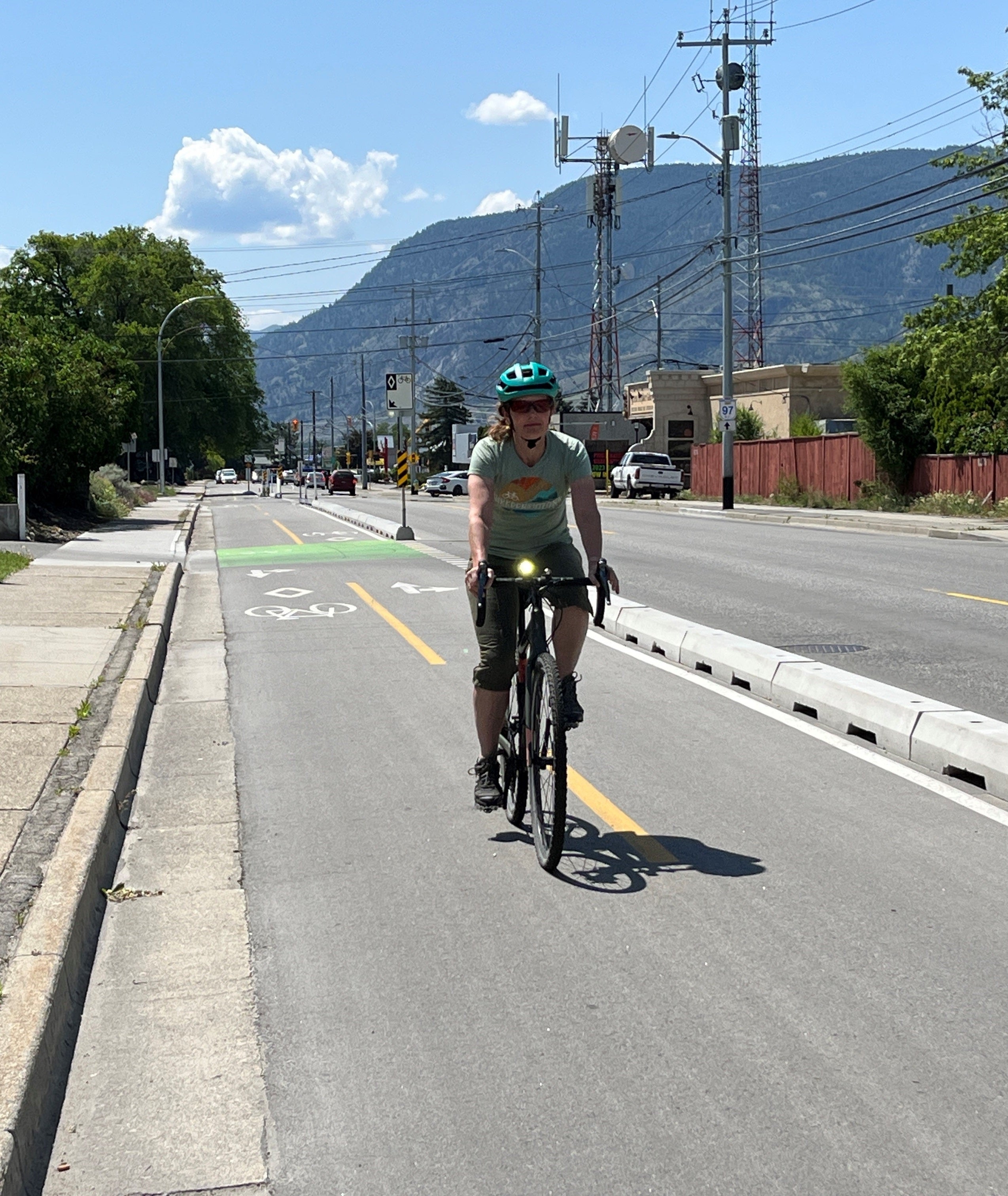[Article] Making cycling safer and more accessible for all

For as long as she can remember, Kimberly Whidden has been cycling on urban and city roads.
“When my sister and I were growing up in Victoria in the 1970s, our parents would take us from Esquimalt to Beacon Hill Park along some pretty busy routes. I don’t think bike lanes were even a thing then,” recalls the Interior Health communications consultant.
Today, Kimberly lives in Penticton, and uses her bike for getting around town, recreation and fitness.

“I love how far the cycling infrastructure has come in so many cities across B.C.,” she says. “Even though I’m comfortable cycling in traffic, I also deeply appreciate the separated bike lanes, bikeways/greenways and multi-use paths that have been built.”
In this Story…
Removing the barriers to cycling
Shifting the cycling safety message
Removing the barriers to cycling
Kimberly may be the exception when it comes to feeling comfortable on the roads, however. Recent research out of Australia showed that the number one reason people didn’t ride for recreation or transport is they didn’t want to ride on the road with motor vehicle traffic.
Which is why Interior Health’s Healthy Community Development team works closely with municipalities to help make cycling safer and more accessible for all.
Kelly is a community health facilitator with the Healthy Community Development team. She and her team advise on community, active transportation and land use plans by providing health information to city staff. “We want to encourage healthy transportation networks that prioritize human-powered transportation like cycling and walking. This includes safe and connected routes to places we work, learn and play,” says Kelly.
“Lower speed limits and traffic calming, as well as regular road maintenance also improves cycling safety.” she adds.
"The health and environmental benefits of cycling are huge. It’s an activity that helps people stay active, and depend less on their cars. Cycling can help lower rates of cardiovascular disease, diabetes and some cancers."
Kelly also points out other important, and sometimes overlooked, benefits. “We also shouldn’t underestimate how cycling can improve our mental health and wellness,” she says. “Getting fresh air and sunshine, spending time in green spaces, and connecting with other cyclists and pedestrians offer enormous benefits. Not to mention, you’re helping the planet when you choose to ride a bike.”
Shifting the cycling safety message
Megan Klammer is an injury prevention and safety promotion lead with Interior Health and the BC Centre for Disease Control. She works within IH and with her counterparts at other health authorities to advance and promote cycling safety throughout B.C.
“When people have confidence that they can ride safely in their community, even when sharing roads with motorized vehicles, they will be more likely to leave their car at home. Preventing serious injuries and deaths for all road users is our Vision Zero BC strategy, and cyclists are a key component in road safety.”
“Cyclists can do their part by wearing their helmet, riding with lights, and wearing bright clothing,” she says. “There is also an increased investment by our road designers, engineers and city planners to create safer spaces for cyclists and other vulnerable road users to reduce interactions with larger and faster moving passenger vehicles.”
Creating healthier communities with safe and accessible cycling
Here are just a few of the ways Interior Health is helping make cycling and other forms of active transportation safer and more accessible around the Interior region.
Improving our roads with Vision Zero grants
Vision Zero is an international best practice in road safety that advocates for zero serious injuries, disabilities and deaths on our roads. From 2022 to 2024, Vision Zero, with the support of the BC Provincial Government, has issued grants for 19 road safety improvement projects across the Interior Health region.
Encouraging students to ride, walk or roll to school
In late April, Dr. Trent Smith, a Kamloops-based IH pediatrician behind the Safer School Streets pilot in Kamloops, presented to parents, teachers, elected officials and community members. He spoke about health trends in children and youth, and highlighted the importance of cycling, walking and using various forms of active transportation, with a goal of getting more kids moving their bodies to get to and from school.
Linking urban planning with health
Interior Health brings a public health perspective at community planning meetings. For example, we participated in engagement meetings for the Regional District of Okanagan’s 10-year Parks, Trails and Recreation Master Plan, published in January 2023.
Some of the plan outcomes (shown on page viii) include active and connected communities, inclusive and equitable access to parks, trails and recreation facilities, and climate change resilience.
Interior Health is also a partner in the Regional District of Central Okanagan’s Clean air and safe routes 4 schools, a program developed to help improve air quality at schools in the Central Okanagan by reducing motor vehicle emissions near school buildings.
Together with city departments, the RCMP and school district representatives, IH helps participating schools encourage students who live less than 2.5km from school to use active transportation. Most recently, we participated in a walkabout at Quigley Elementary School, and shared examples to improve student and parent safety with changes to roads, sidewalks and signage around the school.
Resources
Cycling safety is everyone’s responsibility: cyclists, drivers, and other road and network users. Explore these videos and articles to get tips on cycling safely – and how to make cycling safe for all.
Summer Safety: Bike smart to prevent injury | Interior Health
Bike Sense 7th Edition | BC Cycling Coalition
Cycling safety | ICBC
Sharing the Road With Cyclists | ICBC
The Dutch reach | Fraser Health
10 rules of the road for cyclists | People's Law School
-
Date
Jul 17, 2023
-
By
Interior Health
